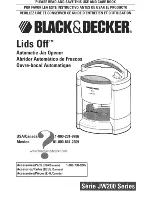
4
ENGLISH
6.4 TIME - SETUP LEARNING
Before any manoeuvre is executed, a SETUP
cycle must first be run.
During SETUP do not interrupt the photocells
because their interruption causes the immedi-
ate stop of the leaves. To end the procedure,
repeat SETUP from the beginning.
When the board is powered up and a SETUP cycle has never
been executed, LEDs LD4 and LD5 begin to flash slowly to signal
that a SETUP cycle must be executed.
There are two possible types of SETUP: AUTOMATIC and
MANUAL
6.4.1
AUTOMATIC SET-UP
To execute an AUTOMATIC SETUP, follow the procedure below:
Take the leaves to mid-point.
Hold down the SETUP (SW) push-button until the 2 adjacent
LEDs (LD4 and LD5) light up on steady beam.
Release the SETUP push-button, LEDs LD4 and LD5 begin
to flash rapidly.
Leaf 2 (if present) starts the closing movement, stopping
when it reaches the closing mechanical stop.
Leaf starts the closing movement, stopping when it
reaches the closing mechanical stop.
Leaf starts the opening movement.
Leaf 2 (if present) starts the opening movement after a
fixed delay at opening.
Leaves and 2 (if present) stop when they reach the
opening mechanical stop.
Wait for LEDs LD4 and LD5 to go OFF, which means that the
SETUP procedure has finished.
Give an OPEN pulse to close the gate.
When the SETUP procedure has been started,
if the leaves at point 4 and 5 open instead of
closing, the motor power supply cables must
be changed over.
When using the AUTOMATIC SETUP, the slow
down spaces, the leaf opening and closing
delays, and the pause time (30 sec., with AP
logic), are all preset by the board and cannot
be modified.
.
2.
3.
4.
5.
6.
7.
8.
9.
0.
LED
ON (closed contact)
OFF (open contact)
STOP
Command disabled
Command enabled
OPEN A
Command enabled
Command disabled
OPEN B
Command enabled
Command disabled
BUS
See par. 7.2
6. START-UP
6.1 LEDS CHECK
The following table shows that status of the LEDs in relation to
the status of the inputs (the closed at rest automated system
condition is shown in bold).
Check the status of the signalling LEDs as per table below:
Tab.1 – Operation of inputs status LEDs
6.4.2
MANUAL SET-UP
To execute a MANUAL SETUP, follow the procedure below:
Take the leaves to mid-point.
Hold down the SETUP (SW) push-button until the leaves
start to move.
Release the SETUP push-button, LEDs LD4 and LD5 begin
to flash rapidly
Leaf 2 (if present) starts the closing movement, stopping
when it reaches the closing mechanical stop
Leaf starts the closing movement, stopping when it rea-
ches the closing mechanical stop
Leaf starts the opening movement.
Leaf 2 (if present) starts the opening movement after a
fixed delay at opening.
Leaves and 2 (if present) stop when they reach the ope-
ning mechanical stop.
If LOW force was set, wait for about 5 sec checking if the
flashing lamp goes OFF.
.
2.
3.
4.
5.
6.
7.
8.
9.
6.2 PROGRAMMING THE DIPS-SWITCH
DS1
DS2
DS3
DS4
Description
OFF
OFF
LOW FORCE
OFF
ON
MEDIUM - LOW FORCE
ON
OFF
MEDIUM - HIGH FORCE
ON
ON
HIGH FORCE
ON
ANTI-WIND ON
OFF
ANTI-WIND OFF
ON
REVERSING STROKE ON
OFF
REVERSING STROKE OFF
If you connect an electric lock to terminal J4,
position DS4 to ON to enable the reversing stro-
ke (before opening, the motors thrust to close,
thus facilitating the electric lock to uncouple).
By setting dip-switch DS3 on ON, a special
By setting dip-switch DS3 on ON, a special
antiwind function is activated that enables the
gate operation even if strong wind is present.
The following tables show the settings of the DS dip-switch for
programming force, pre-flashing and reversing stroke.
Tab. 2 - DS1 programming (default settings in bold)
6.3 PRE-FLASHING
The pre-flashing function can be activated and disabled (fol-
lowing an OPEN command, the unit activates the flashing lamp
for 3 seconds before it starts the movement). Procedure:
Press LOGIC key (SW3) for at least 5 secs. to ACTIVATE
pre-flashing.
Press SPEED key (SW2) for at least 5 secs. to DESACTIVATE
pre-flashing.
In both cases check if the LED of the pressed key
changes its status: in such cases it means that
the function of the key and not the pre-flashing
was changed.
.
2.
Summary of Contents for E391
Page 1: ...E391...




























